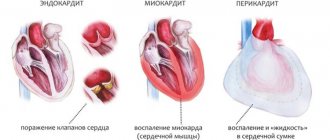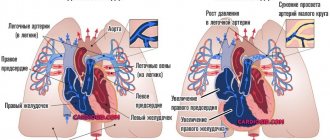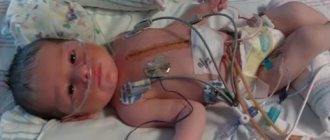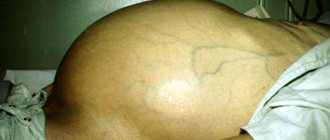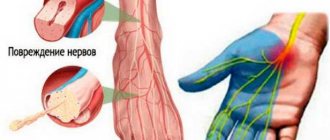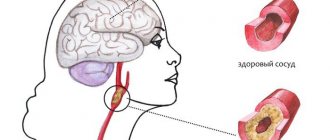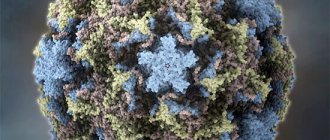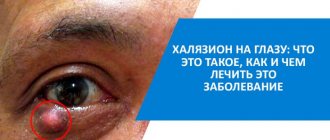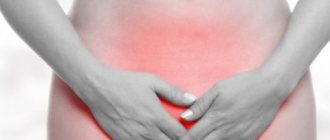The symptom complex of vegetative-vascular dystonia includes many manifestations that affect the functioning of almost all organs. Extrasystole with VSD is a very common symptom and accompanies almost every VSD patient. It is exclusively neurological in nature and in most cases does not threaten the patient’s life, but it brings a lot of inconvenience and leads to an exacerbation of the disease.
Communication mechanism
On the right side of the heart, between its upper chamber, the atrium, and the lower, the ventricle, there is a cluster of cells that differ in structure from the rest of the myocardial fibers - the sinus node. It is here that an electrical impulse is generated, which, when distributed to the entire heart muscle, provokes its contraction, called systole. The frequency and order of myocardial contractions depends on the functioning of the sinus node. Therefore, this formation is also called the main pacemaker of the heart rhythm.
The electrical excitability of the sinus node is controlled by the autonomic part of the nervous system, which is responsible for the functioning of all organs. This determines the dependence of the rhythm and heart rate on the degree of excitability of the nerve fibers.
The amount of mediators produced, acetylcholine and adrenaline, which affect the speed and intensity of nerve impulse transmission, depends on the following factors:
- the presence of acute and chronic diseases in the body;
- taking certain groups of medications;
- hormonal balance;
- health of the spine and its ligaments;
- psycho-emotional state of a person.
The stronger the emotions a person experiences, the more adrenaline he produces. This biochemical reaction leads to increased excitability of the autonomic nervous system, which provokes increased heart rate and the appearance of extraordinary myocardial contractions - extrasystoles. Therefore, neurosis and extrasystole are closely intertwined.
Extraordinary contraction of the myocardium is accompanied by a number of unpleasant sensations:
- rhythm disturbance is accompanied by a feeling of “interruption” or “failure” in the work of the heart muscle. This is due to the compensatory pause that occurs after the extrasystole, which is perceived as cardiac arrest;
- sometimes patients describe their sensations as “turning over”, “freezing” or “tumbling” of the heart;
- the physiologically determined intense shock of the myocardium following the pause is perceived by the patient as an increased heartbeat;
- a disruption in the rhythm of contractions leads to the appearance of emotions such as anxiety and fear of death.
At the peak of emotional experiences that arise after extrasystole, patients note increased sweating, pale skin, and a feeling of “lack of air.” Increased attention to your experiences aggravates the excitability of the nervous system, which leads to the appearance of a new extrasystole.
Clinical examination usually reveals no changes confirming the presence of pathological processes. In only about 5% of patients, extraordinary contraction of the myocardium is caused by organic diseases that disrupt the functioning of the heart rhythm driver.
general information
One of the most common heart diseases is extrasystole. This term refers to disturbances in the rhythm of the heart muscle, in which it contracts prematurely .
It is very easy to identify this disease using an ECG, which shows rapid or premature extrasystolic complex.
In general, a premature complex can be either extrasystolic or parasystolic . The fact is that extrasystoles and parasystoles are integral attributes of the work of the main muscle in the body, and the treatment of disturbances in their rhythm is absolutely the same.
Extrasystole can be localized in the ventricles of the heart, as well as in the supraventricular region, in the atrial and atrioventricular regions.
How to cope with psychogenic extrasystoles
There is no specific treatment for extrasystoles caused by psycho-emotional experiences.
When people come to me with complaints about extrasystole, which appears against the background of the health of the heart and other organs and systems, I, first of all, try to explain to patients that their condition is not a disease, but an individual characteristic of the body.
In a situation where symptoms of psychogenic extrasystole begin to appear, it is important to learn to keep the situation under control. You should not concentrate your attention on uncomfortable sensations, but try to switch to everyday worries as soon as possible. It is useful at this time to start doing something that requires concentration. This could be handicrafts, drawing or another type of creativity.
Manifestations of psychogenic extrasystole cannot be controlled with medication, and the success of the actions taken mainly depends on the efforts made by the patient himself.
Level of danger and general features
It is worth saying that none of the researchers classifies extrasystole as a dangerous ailment of the heart muscle.
Campbell and other world-famous cardiologists view it primarily as a “cosmetic” heart failure, which does not in any way affect the quality of this work.
However, if extrasystole is frequent, and symptoms of tachycardia, “jogging” of the rhythm, are also noticed, then this should definitely become a reason for examination so that doctors can clearly understand the cause of such a disorder.
After all, the symptoms of this disease may hide much more significant and dangerous ones, so an examination must be scheduled and completed without fail.
Symptoms that can lead to therapy for extrasystole are:
- Hemodynamic disorders that are caused by an uneven rhythm of the heart muscle.
- A person’s own feelings when he himself feels instability of the heart rhythm, which brings discomfort.
- Upon examination: structural changes, as well as deterioration of the myocardium, which can lead to very serious consequences without medical intervention.
Several cases from practice
Patient A., 28 years old. Complaints about periodic “failures” in heart function and tachycardia that manifests itself during the day. Works as a web designer in an office. Unfavorable working conditions at work: noise in the office, pressure from superiors, frequent overtime. The girl had a feeling that her work was underestimated. Lives with parents. Domestic conflicts often arise in families. An examination by a therapist did not reveal the presence of pathologies in other organs and systems. Recommended: ignore episodes of extrasystole, change the work environment. Improvement occurred after switching to remote work and attending sessions with a psychologist to resolve family conflicts.
Patient O., 36 years old. Housewife. Complaints of “interruptions in the heart,” followed by a feeling of increased pounding in the chest. After this, sweating increases sharply and a feeling of fear appears. Attacks occur during family conflicts provoked by a husband who abuses alcohol. Examination of the cardiovascular system revealed no pathology. The thyroid gland, liver, kidneys are unchanged. General analysis of urine and blood is normal. She ignored advice not to take her condition into account or to contact a narcologist or psychologist. On the second visit, the condition remained unchanged.
What is characteristic of vegetative-vascular dystonia
It is important for a VSD patient to understand that his arrhythmia is of a functional nature. And no matter where exactly and in what quantity it occurs, one thing is clear: the heart is healthy, and the reason lies in something completely different.
Extrasystole in such patients manifests itself when a large amount of adrenaline enters the blood. But as soon as it decreases to normal, all sensations subside. That is, the problem is temporary and reversible. But patients tolerate it very hard. For them, this is like death: heart failures catch them suddenly, they can be repeated for several months and even years, until the cause is eliminated.
At this moment, a person is seized by a feeling of fear. He begins to choke, his legs give way, and he may lose consciousness. The patient becomes pale, begins to rush about, and scream. The sensation in the chest resembles a blow to the rib cage.
An even greater fear is the compensatory break after an extraordinary compression. The patient fears that his heart will stop. It seems to him that he will die, and this cannot be avoided.
If the excitement intensifies, then the symptoms worsen. Atrial fibrillation occurs. It seems that the heart works outside the regime, chaotically, as it pleases. Fortunately, this condition rarely occurs.
Doctor's advice: how to prevent extrasystole
I recommend eliminating or minimizing all stressors that cause anxiety, depression, or other negative emotions.
At the same time, a favorable psychological microclimate is necessary both at work and in the family. You should also reconsider your relationships with people with whom you have frequent contact. Neighbors, friends, and relatives can provoke an attack of extrasystole. Activities aimed at increasing stress resistance are also recommended:
- normalize your daily routine. Create conditions for a good night's sleep, alternate mental work and physical activity;
- adjust nutrition. Eat enough fresh vegetables and fruits daily;
- before going to bed, take walks in the fresh air away from streets with heavy traffic;
- engage in a feasible sport;
- pay attention to water procedures every day.
If these techniques do not help, it is advisable for the patient to master simple psychological relief skills, for example, meditation, auto-training, yoga.
In the vast majority of cases, such recommendations help solve the problem on your own. It is extremely rare to recommend consulting a psychologist or psychotherapist.
Distribution by age and gender
It is worth saying that this heart disease is common in men . This is due to the fact that men smoke cigarettes more often, and are also susceptible to various other negative factors. The incidence of this disease increases with age. In women, this disease is also quite common, but usually in non-critical forms.
Extrasystole is common among teenagers, as age-related changes affect the functioning of the entire body, including the heart muscle. In addition, the body in children is quite weak, so the heart does not always work correctly and extrasystole is possible.
What are the symptoms of the pathology
Symptoms of extrasystole are:
- periodic sensation of heartbeat;
- freezing in the chest;
- feeling that the heartbeat is arrhythmic;
- lack of air due to chest discomfort;
- failure of breathing rhythm;
- syncope (temporary loss of consciousness).
The occurrence of extrasystoles in the supine position
If the sensation of a change in the functioning of the myocardium manifests itself in the supine position, this indicates the functional nature of the extrasystoles that occur. Symptoms disappear when moving to a sitting position, the pulse becomes rhythmic. This arrhythmia does not pose a danger to the body. In this case, standard drug therapy will be ineffective; taking sedatives will be an effective solution.
conclusions
Extrasystole is an extraordinary generation of an impulse followed by a contraction of cardiomyocytes. Extrasystoles are sometimes harmless, but in other cases they can provoke atrial fibrillation, the consequence of which will be sudden death.
The army will perceive a cardiological conclusion about the presence of polymorphic, paired or group extrasystoles negatively and will deny the man the opportunity to serve.
Prevention of extrasystole - a healthy lifestyle (physical exercises during sedentary work are required).
Question answer
Ekaterina: Hello, for five years now I have felt my heart sink - extrasystole, 10 times a day. I have autoimmune thyroiditis, euthyroidism, cholesterol and sugar are normal, heart echo is without pathology, blood pressure is 110/70, if I’m worried - and Pulse and blood pressure increase. Height - 167, weight - 69. Especially when taking a deep breath, I feel extrasystoles. Tell me, is this treatable and what tests still need to be taken to determine the cause?
Ask a question
Make an appointment
Question answer
Q: How much will a breast lift cost? Catherine
A: A breast lift will cost 120 thousand rubles. (with anesthesia and hospital stay). In some cases, to get good shape.
Q: Good afternoon, can you tell me how much breast plastic surgery is “turnkey”? Are there any discounts or promotions for this operation? Thanks, have a nice day! Alina
O: Hello. The cost of the operation with anesthesia, hospital stay and implants will be about 160 thousand rubles.
Q: I have protruding ears since childhood, my ears have stuck out like a monkey’s, I wanted to ask how much the surgery to correct it will cost, and from what age (with parental consent) Anita
A: The operation to correct protruding ears costs 40 thousand rubles. Recommended to do from 6 years old. After that, you can do it anywhere.
Discounts
There are currently no discounts at Pokrovskaya Hospital. For detailed information, please contact the paid services department, tel. (812) 322-03-03, 322-08-08.
Prevention of extrasystolic arrhythmia
It is based on a number of measures that can be applied to almost all cardiovascular diseases.
- the diet should be balanced and maximally rich in heart-healthy foods (apples, pomegranate, nuts, avocado, seeds, salmon, salmon, olive and flaxseed oil);
- physical activity should be moderate and alternate with rest;
- if necessary, you need to regularly take medications prescribed by your doctor;
- physiotherapy, if recommended by a doctor, will help strengthen the heart muscle;
- You should give up bad habits (smoking, alcohol) and avoid stressful situations.
Video: Extrasystole
4.40 Aug. rating ( 87 % score) - 10 votes - ratings
Treatment
Classes of antiarrhythmic drugs used:
- fast sodium channel blockers: slightly affecting conductivity: lidocaine, phenytoin, mexiletine;
- moderately slowing down the passage of the impulse: ajmaline, quinidine, procainamide;
- significantly inhibiting depolarization: propafenone, etacizin, alapinin;
Review studies and self-prescription of drugs for arrhythmic manifestations for some reason turn out to be ineffective. Only a doctor can make a diagnosis after analyzing the ECG, and he will also select the appropriate medication in an individual dosage.
To enhance the antiarrhythmic effect, drugs from different groups are used in combination.
Possible consequences and complications
If you do not fight the problem in any way, then this “cosmetic” disease can develop into tachycardia , which is much more serious.
In addition, the likelihood of myocardial infarction may be increased , so it is necessary to deal with this disease if it has already occurred and the doctor talks about it. Otherwise, the consequences can be much more detrimental to the main muscle that disperses the blood. Extrasystole can be regarded as the first “bell” that can signal problems.
If you start therapy (if it is needed) promptly, then there can be no consequences or complications.
